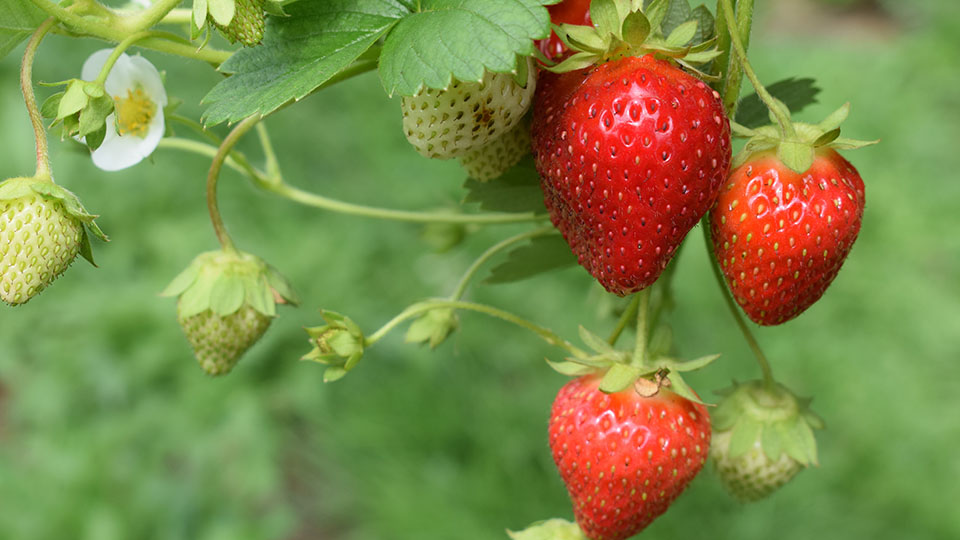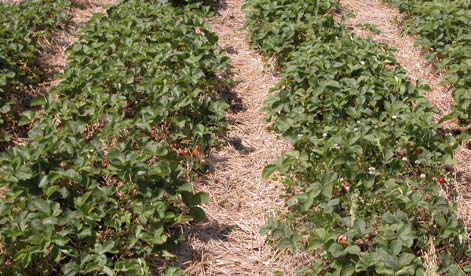How to Grow Strawberries in Your Garden

Summary
Strawberries are one of the most popular small fruits in the home garden. The attractive plants are relatively easy to grow, require minimal space, and produce the first fruit of the new season. A properly maintained 4 feet by 8 feet bed of strawberries will produce 10 to 15 pounds of berries per year for three to five seasons.
How to Grow Strawberries
Site Selection
Select a sunny location with welldrained soil. Strawberries require at least eight hours of full sun each day of the growing season to produce at their maximum capability. Strawberries grow best in loamy or sandy soils. Heavy clay soils cause reduced plant growth and vigor and a higher incidence of disease. However, clayey soils will work if they are well drained. Planting in raised beds will improve soil drainage and aeration of heavy soils.
Strawberry blossoms are susceptible to late spring frosts, which can kill the early flowers that produce the largest berries. Situating strawberry beds on a north slope or north side of a fence or building provides late winter shade that will help to delay bloom until spring frosts are less likely. Plantings with a southern exposure may bloom and crop earlier, but are more susceptible to spring frosts. Covering blooming plants with tarps or blankets on cold nights will help protect flowers and developing fruit.
Avoid keeping strawberry beds in the same place for more than five years to prevent buildup of soilborne pathogens. Also, avoid planting strawberries in areas where peppers, tomatoes, potatoes, eggplant, or okra, have been grown recently, as these harbor the Verticillium wilt pathogen.
Site Preparation
The soil should be prepared well in advance of planting. Incorporate organic matter (2-3 inches of compost) in the bed to a depth of at least 12 inches. Organic matter will help improve nutrient availability as well as the structure and water-holding capacity of the soil. Also incorporate a balanced fertilizer such as 10-10-10 into the planting bed at the rate of ½ to 1 lb per 100 sq feet. Strawberry plants are highly sensitive to salt. High salt levels (greater than 1.8 ECe dS/m) will cause stunting, marginal leaf scorch, severe yield reduction, and even plant death. Avoid planting in salty soils or apply enough water to ensure that salts are leached below the root zone. Also, be careful not to over fertilize. A soil test will provide information on salinity and initial fertilizer needs. Contact your county agent for information on submitting soil samples for testing, or visit the USU analytical laboratory Web site for instructions (http://www.usual.usu.edu/).
Strawberries do not compete well with weeds, and perennial weeds are particularly difficult to control. Sites should be free of perennial weeds before planting, and may require pre-plant applications of a non-selective herbicide to reduce perennial weed pressure.
Plant Selection
Strawberry varieties are categorized into three types according to their flowering and fruiting habit. June-bearers initiate flower buds under the short days of autumn, with the flowers opening the following spring, and the subsequent fruit ripening in late May to June. Everbearers initiate flower buds under long days and will generally produce a small crop in the spring and crop again in the fall. Day-neutrals initiate flower buds regardless of day length when temperatures are below about 70°F. In cool climates, day-neutrals can continue to produce a light crop throughout the summer. However, summer temperatures in Utah are generally too warm for season long production. Under most home garden conditions, Everbearers and Day-neutrals behave similarly and many nurseries and gardening books use these terms interchangeably. In fact, many of the newer varieties sold as everbearers are actually day-neutrals.
Making general variety recommendations is difficult, as the acceptability of a given strawberry variety depends upon soil type, local climate, and personal taste. Following are a few varieties that have done well under a wide range of conditions:
Junebearers
Earliglow is among the earliest fruiting varieties and is considered by many to be the gold standard for flavor. Fruit size on secondary blossoms is below average.
Chandler is an early mid season variety from California that yields well and has large fruit. The plant is vigorous and adapts well to a range of conditions, but may not be hardy enough for the coldest regions of Utah. The fruit shows some tolerance to gray mold fruit rot.
Honeoye is the most popular home variety in the U.S. due to high yields of large fruit that ripen in early mid season. This variety is not well suited to many parts of Utah as it does not do well on heavy soil, and the fruit develops an off flavor when it ripens in hot weather.
Allstar is a good choice for midseason fruit as the plants are more tolerant of hot weather and are resistant to root rot, powdery mildew and Verticillium wilt. The fruit are large and sweet.
Jewel is a cold hardy variety that produces late season large fruit of excellent quality, and is a consistent producer. However, the plants are susceptible to root rot and some leaf diseases.
Sparkle is a long time favorite for home gardens. The medium sized fruit are very flavorful and prized for jams and freezing. The plants are cold hardy, vigorous and show resistance to at least one type of root rot.
Everbearers and Day-neutrals
Ogallala is a cold hardy everbearer that produces medium-sized flavorful dark red fruit. The plants are vigorous, productive and somewhat drought tolerant.
Seascape is a day neutral from California that has proven to be productive in a wide range of climates. The large flavorful fruit are good for fresh consumption. Plants are resistant to Verticillium wilt.
Tribute is a day neutral from the Eastern U.S. that is a vigorous productive plant resistant to gray mold fruit rot, Verticillium wilt, and red stele root rot. The fruit is medium sized with good flavor.
Evie 2 is a day-neutral recently imported from England that produces medium large fruit. It might be worth a try in a home garden, as it is believed to be higher yielding and more heat tolerant than other day-neutrals.
Regardless of the variety you select, start with clean disease- and virus-free plants from a reputable nursery. Resist the temptation to transplant from an existing bed as you will likely be starting off with plants that have plant viruses or root rot diseases that will limit the success of your new planting. A list of strawberry nurseries that sell mail-order plants is frequently published in the Utah Berry Growers Association newsletter. Back issues of the newsletter containing strawberry nursery information are available online (http://extension.usu.edu/publications).
Management Systems
Strawberry plants propagate themselves by sending out runners (stolons) that form daughter plants. The two management systems best suited to home garden production are the Matted Row and the Annual Hill systems, and differ in how they handle runners. The Matted Row system is often easier to manage effectively, but the annual hill system also has advantages in weed and disease management and improved fruit size and quality.
Matted Row

The matted row system is generally used for June-bearers. Bare root dormant plants are transplanted in early spring. Since the plants are dormant, there is no need to wait until after the risk of spring frost has passed. Plants are placed 18 to 24 inches apart within the row, with rows three to four feet apart. During the first growing season, blossoms and fruit are removed to promote runners and the formation of daughter plants. The soil surface within the row should be kept loose and moist to promote rooting of the daughter plants, which should form a continuous “mat” of plants within the row during the first season.
Cultivation between rows will control weeds and contain the strawberry plants within the row. One problem with the matted row is that too many plants can form that compete with each other, resulting in smaller berries. The easiest way to manage this is by narrowing the rows with cultivation. The optimum row width for yield and fruit size is about 8 to10 inches, but a 12 to 18 inch wide row may be more practical.
In colder regions of the state, strawberries will need the protection of a winter mulch to prevent damage to the crowns and roots. Clean straw or shredded tree leaves should be spread over the bed in late November, to a depth of 3 to 6 inches. Do not use heavy mulches such as grass clippings as these will smother the plants. Remove the mulch in the spring when new growth begins to appear from the crown. This mulch should be left between the rows to reduce weed growth and keep the developing fruit from contacting bare soil. Remember that once the mulch is removed, the emerging flower buds are sensitive to frost. Protect these developing blossoms on frosty nights by covering the rows with a tarp or blanket to hold warm air near the ground.
A matted row planting of June-bearing strawberries will produce the first crop in the spring of the second growing season. To keep the planting productive for multiple seasons, the rows should be “renovated” immediately after harvest is complete. Renovation should include removing weeds, cultivating to narrow rows, and fertilizing and irrigating to promote the formation and rooting of new daughter plants. You may also choose to hand pull the oldest woody multicrowned plants to make room for new daughter plants.
Annual Hill

The hill system is commonly used for everbearing and day-neutral types, but can also be used for June-bearers. Plants are spaced 12 to 15 inches apart in the row, with staggered rows spaced 12 to 15 inches apart and 2 to 4 rows per bed. Runners are removed so that only the mother plants grow and produce fruit. Because there are no daughter plants to root down, a plastic mulch can be used to prevent weeds between the plants and to provide a clean surface for developing fruit. Beds can be raised as shown below, or level with the remaining garden. Drip irrigation or a soaker hose will be needed to supply water under the plastic mulch.
For everbearers and day-neutrals, plant dormant bare-root plants early in the spring. Remove the first flower cluster that emerges to give the plants more time to establish their root system. The plants should then begin fruiting about the time that the June-bearing varieties have finished their season. In many areas of Utah, summer temperatures are too warm for dayneutrals to continue fruiting throughout the summer (>75°F), so typically these plants will produce a late spring crop and then fruit again in the fall. The amount of fruit produced will generally be less than that produced by a June-bearer. Since daughter plants are not allowed to form, the mother plants usually run down after one or two seasons, and are usually replanted after one or two seasons.
The annual hill system can also be used with June-bearing varieties that are planted in mid to late summer and fruited the following spring. These may be grown as an annual, or may be carried over for a second crop. This type of annual hill system will produce the highest yields and largest fruit size, and requires determining the optimum planting time. Allstar and Chandler are two varieties well adapted to this system. For best results, the plants need to be established early enough to allow for the development of multiple crowns per plant (3 to 5), but late enough that runner production is minimized. One challenge of this system is finding a source for plants in mid summer.
Raised beds put the roots at greater risk of winter injury. Raised beds and plastic mulch will also cause the soil to warm earlier in the spring resulting in earlier bloom. Care should be taken to protect the plants with winter straw mulch and the use of tarps or blankets during spring frosts.
Container Gardening
Due to their small root system, strawberry plants do well in containers including planters and barrels. For best results, container gardens should be managed as described for the annual hill system. Irrigate frequently to keep the root system cool and moist, and avoid using dark colored containers that will heat the roots when exposed to summer sunlight.
Planting
Remove dead leaves before planting. Spread the roots out in the planting hole and then firm the soil around the plant. Only the roots and the base of the crown should be covered with soil, leaving as much of the crown above ground as possible. Do not allow the roots to dry out during planting, and water in the new transplants to ensure good root-soil contact.
Fertilizing

Strawberries require relatively little fertilizer compared to garden vegetables. In addition to the pre-plant incorporation of a balanced fertilizer, matted row strawberries should be fertilized at renovation and again in late summer. Apply 5 to 8 pounds of 10-10-10 (½ to ¾ pounds of actual nitrogen) per 100 feet of row at renovation. Apply an additional 3 pounds of 10-10-10 in August to ensure good flower bud formation for the following season. Irrigate immediately after fertilizing to wash the fertilizer from the leaves and down into the root zone.
The most common nutrient deficiency in Utah strawberries is iron chlorosis, characterized by interveinal yellowing. Apply a chelated iron such as Miller’s Ferriplus or Sequestrene 138 in May and again in September at a rate of 0.1 ounce per 100 feet of row.
Irrigation
Strawberry plants have a relatively shallow root system with the majority of the roots in the top 10 to 12 inches. Strawberries also have a relatively high water demand, transpiring up to two inches of water per week in hot dry weather. Irrigate thoroughly at three to five day intervals during the summer heat. Allow the soil to dry somewhat between irrigation cycles to prevent root rot. Drip or trickle irrigation is recommended, as flood or furrow irrigation will spread root rotting pathogens, and frequent sprinkler irrigation will increase gray mold fruit rot. If using sprinklers, only irrigate in the morning to allow fruit and foliage to dry out in the afternoon.
Problems with Growing Strawberries
Weeds
The most common limiting factor in the life of a strawberry patch is weeds. Strawberries do not compete well with weeds for water and nutrients. Use herbicides and cultivation to prepare a weed free area before planting. Plastic mulch used in the annual hill system is effective for within-row weed control, and straw mulch does provide some weed control in matted row production. Both will also require some hand weeding. Systemic herbicides such as RoundUp® should not be used in or around strawberry beds, particularly in matted rows. The plants in a matted row remain as an interconnected network, and a systemic herbicide that reaches a daughter plant will move back through the network, killing or injuring plants in an extended area.
Diseases
Plant viruses are a common problem in strawberries. These viruses are not harmful to humans and generally do not cause visible symptoms to the strawberry plants other than decreased growth and poor plant vigor. Once plants are infected, there is no treatment or cure. Remove old plantings that no longer show adequate vigor, and always start new beds with disease-free plants.
Root, crown and fruit rots caused by fungal pathogens can be a problem with strawberries. Cultural controls include starting with disease free nursery plants, selecting a site that has not recently had strawberries and that has well drained soil, and careful irrigation management. For chemical control strategies, see the “Utah Home Orchard Pest Management Guide” (online at http://extension.usu.edu/publications).
How to Harvest and Store Strawberries
For best quality, fruit should be harvested every other day. Over-ripe fruit may develop off flavors and attract insects and diseases. Pick ripe fruit into shallow containers no more than three inches deep to prevent bruising or crushing. To maximize shelf life, pick fruit in the cool morning hours and refrigerate as soon as possible. Store cooled fruit in vented plastic bags or in the crisper as higher humidity will help to maintain fruit firmness. Do not wash fruit at harvest time as this will increase fruit rot. Wash and remove caps just before eating or processing.
Additional Resources
Utah State University Extension publications available at http://extension.usu.edu/publications.
Fruit related resources:
- Iron Chlorosis in Berries
- Utah Home Orchard Pest Management Guide
- Utah Berry Growers Association Newsletter
General resources:
- Preparing Garden Soil
- Soil Testing Guide for Home Gardens
- Salinity and Plant Tolerance
- Using Compost in Utah Gardens
Utah State University Extension
Peer-reviewed fact sheet
Download PDF
Authors
Brent Black, USU Extension Fruit Specialist; Michael Pace, Box Elder County Agent; Jerry Goodspeed, Weber County Agent
Related Research










